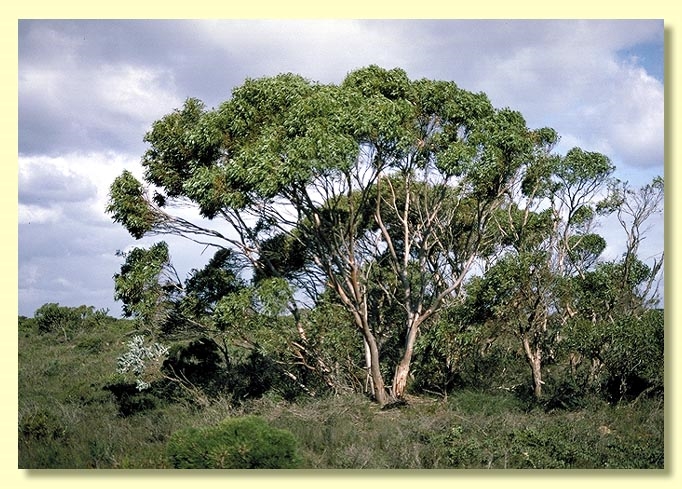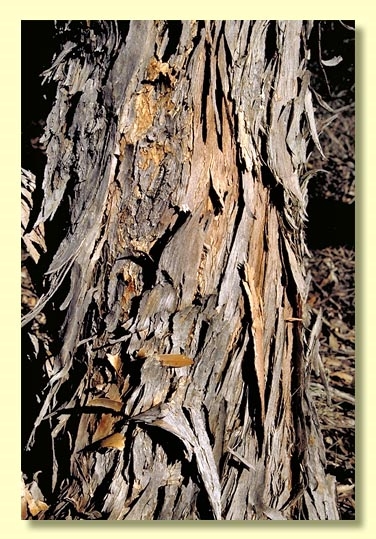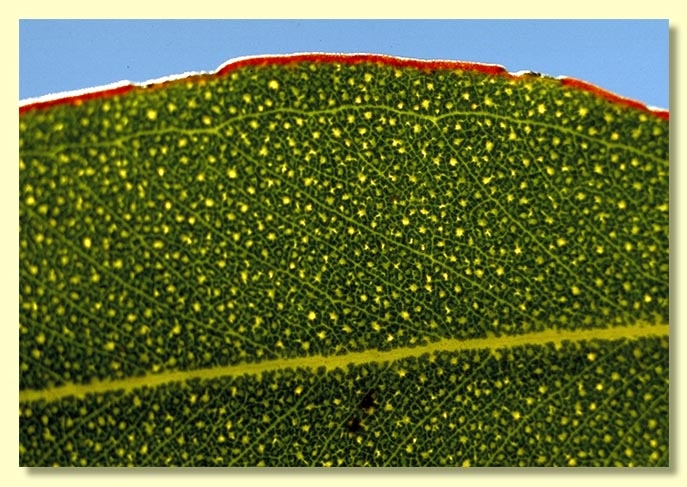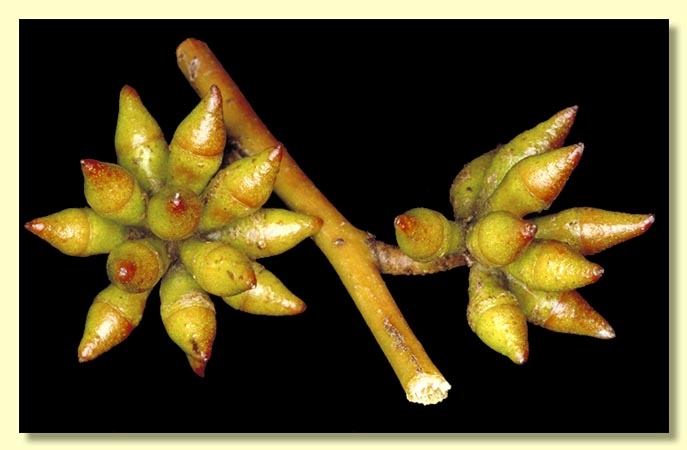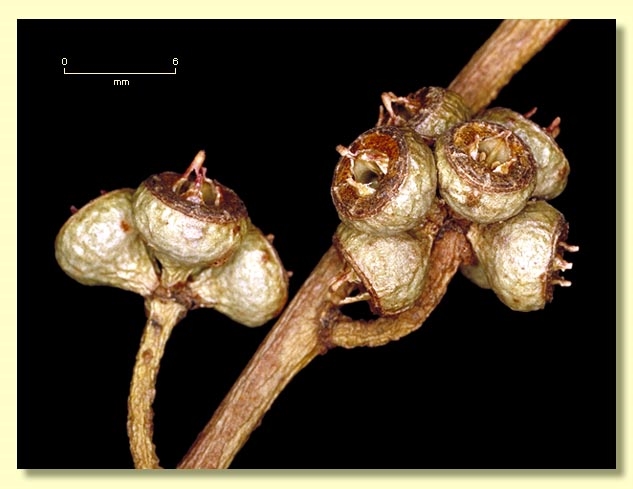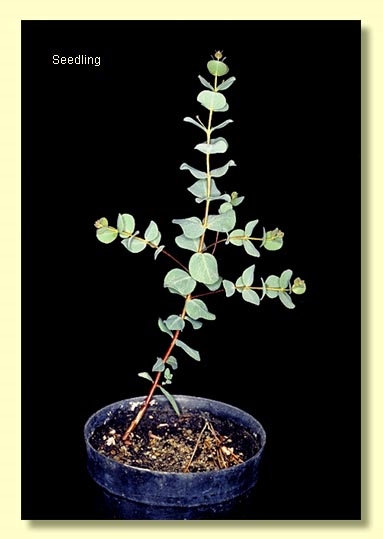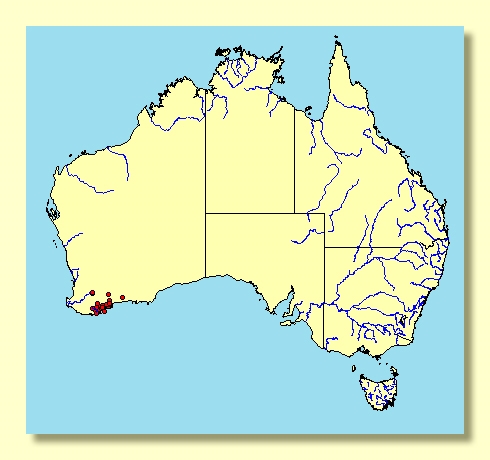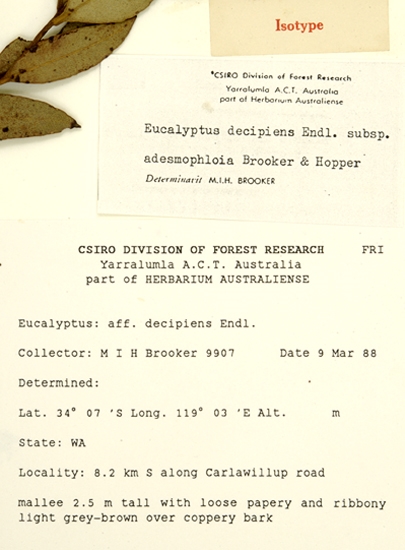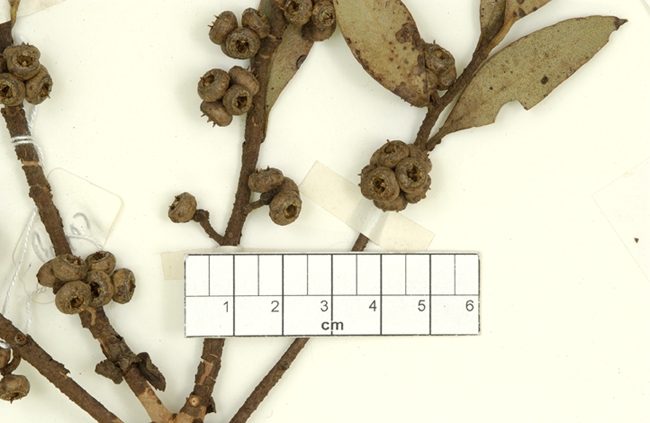Eucalyptus | Symphyomyrtus | Bisectae | Destitutae | Falcatae | Decipientes
Euclid - Online edition
Eucalyptus adesmophloia
Eucalyptus adesmophloia (Brooker & Hopper) D.Nicolle & M.E.French, Nuytsia 22(6) 448-450 (2012).
E. decipiens var. angustifolia Schauer in J.G.C.Lehmann, Pl. Preiss. 1: 130 (1840). T: Cape Riche, W.A., Nov. 1840, L.Preiss 241; iso: G. (tentatively placed in synonomy here - isotype not seen by the authors of EUCLID - decision made based on locality).
Bark partly rough with loose, papery or brittle ribbons of imperfectly shed pale grey-brown bark on at least base of or over most of trunk, smooth bark whitish to pink, pale orange or grey.
Branchlets lacking oil glands in the pith.
Juvenile growth (coppice or field seedlings to 50 cm): stems rounded in cross-section; juvenile leaves shortly petiolate, opposite for very few nodes on coppice, soon alternate, orbicular to broadly elliptical, 2–6.5 cm long, 2–5 cm wide, base tapering, margin entire or subcrenulate, apex emarginate or rounded and apiculate, dull, slightly blue-green.
Adult leaves alternate, petioles 0.4–2.2 cm long; blade lanceolate, 5.5–12.5 cm long, 1–2.5(3.2) cm wide, base tapering to petiole, margin entire or sometimes subcrenulate, apex acute, glossy, green, side-veins greater than 45° to midrib, reticulation dense to very dense, intramarginal vein remote from margin, oil glands numerous, irregular and intersectional.
Inflorescence axillary unbranched, peduncles 0.3–1.2 cm long, buds ?11 to 21 per umbel, sessile or shortly pedicellate (pedicels 0–0.3 cm long). Mature buds squatly ovoid to fusiform (0.7–1.2 cm long, 0.35–0.5 cm wide), scar present (outer operculum shed early), operculum conical to beaked, stamens inflexed, anthers reniform, versatile, dorsifixed, dehiscing by longitudinal slits that remain separate, style long and straight, stigma more or less rounded, locules 3 or 4, the placentae each with 4 vertical rows of ovules. Flowers creamy white.
Fruit sessile or shortly pedicellate (pedicels 0–0.2 cm long), broadly obconical to flattened-hemispherical, 0.4–0.6 cm long, 0.5–0.9 cm wide, disc more or less level, valves 3 or 4, exserted but tips fragile.
Seeds dark greyish brown, 1–2 mm long, ovoid or flattened-ovoid, dorsal surface smooth, hilum ventral.
Cultivated seedlings (measured at ca node 10): cotyledons Y-shaped (bisected); stems rounded in cross-section, smooth or slightly warty; leaves opposite to sub-opposite, becoming alternate variably from ca node 6 to 16, sessile (for at least 20 nodes on some) or shortly petiolate for many nodes, orbicular and often wider than long, 1.5–3 cm long, 1.5–4 cm wide, base truncate, rounded, amplexicaul or tapering, margin entire or subcrenulate, apex emarginate to rounded, grey-green to green, dull.
Flowering has been recorded in August, September, November and January.
Eucalyptus adesmophloia is a mallee species endemic to Western Australia occuring in coastal and sub-coastal areas from the southern and eastern part of the Stirling Range to Manypeaks and the Bremer Bay area extending to the western part of Fitzgerald River National Park, in mallee heathland on white sandy soil. It has imperfectly shed loose rough bark on the trunks, glossy green adult leaves, and more or less sessile pointy buds in distinctive clusters of up to 21.
In his classification of the eucalypts Brooker (2000) placed Eucalyptus adesmophloia (as Eucalyptus decipiens subsp. adesmophloia ) in Eucalyptus subgenus Symphyomyrtus section Bisectae subsection Destitutae because buds have two opercula, cotyledons are Y-shaped and branchlets lack oil glands in the pith. Within this sub-subsection E. adesmophloia, E. decipiens and E. obesa form a distinctive small group, series Falcatae subseries Decipientes, with shortly stalked or sessile buds in crowded stellate clusters in the leaf axils, crowded fruit and with adult leaves having numerous side-veins, dense reticulation and intersectional oil glands. Three other species, E. communalis, E. balanites and E. phylacis were formerly included in subseries Decipientes, but are now regarded as hybrids or intergrades.
E. decipiens is distinguished from both E. adesmophloia and E. obesa by its persistent tightly held rough fibrous bark over trunks and branches. E. obesa differs from E. adesmophloia by completely shedding bark to leave clean smooth trunks, buds in clusters up to 13 (up to 21 in E. adesmophloia ) and having slightly larger fruit (but with some overlap in dimensions). All three species have distinctive emarginate to rounded and apiculate juvenile leaves.
Eucalyptus adesmophloia intergrades with E. decipiens in the Stirling Ranges forming plants with bark characteristis intermediate between the two species. In earlier editions of EUCLID these plants were treated as E. decipiens subsp. chalara Brooker & Hopper.
Occasionally plants are found emergent from heathland in Fitzgerald River National Park that are intermediate in form between Eucalyptus adesmophloia and E. obesa. They form distinctive clumps of slender smooth-barked mallees and are not common. They have slightly fatter pointy and more cylindrical buds than does E. adesmophloia and but lack tthe shorter more rounded apiculate operculum of E. obesa. These plants were originally described as Eucalyptus communalis Brooker & Hopper and treated as such in earlier editions of EUCLID but are now considered to be rare intergrades between these two species.
For further discussion of these intergrades see Nicolle & French (2012) through this link:
http://florabase.dpaw.wa.gov.au/science/nuytsia/653.pdf

